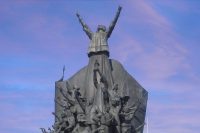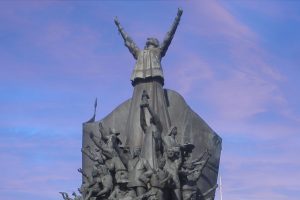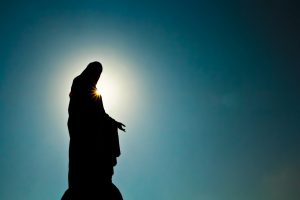On “Black Saturday,” preparations are made for the late-night Easter vigil at church. There, the Gloria is sung, and some call it “Glorious Saturday.” In some places, an effigy of Judas is hung and burned up, though sometimes, he is blown to pieces by firecrackers. At midnight, the fasting and mourning ends because it is finally the day on which Christ arose from the grave in victory.
A 4am on Easter Morning, a ceremony commemorates the meeting of Mary and Jesus after the Resurrection. The black-veiled image of Mary is unveiled by one or more people dressed up like angels, and sometimes, the veil is tied to balloons or a dove to be carried away in the air. The image of Christ also is unveiled, and flowers and confetti fall down on the statues of both Mary and Jesus. Bells ring and fireworks explode in the sky. Legend has it, however, that if the veil is removed only with difficulty, bad luck will accompany the year to come.
Eidul Fitr is an important celebration for Filipino Muslims, marking the end of the month-long fast during Ramadan. In 2020, Eidul Fitr falls on Monday 25 May. President Duterte has signed Proclamation No. 944 to confirm the holiday throughout the country.
Originated by the Islamic Prophet Muhammad, Eidul Fitr is a celebration of thanksgiving to Allah. Eidul Fitr has been proclaimed a national holiday in the Philippines since 2002. This proclamation was made to foster peace and goodwill between major religions in the Philippines.
Eidul Fitr is celebrated using the Islamic calendar “Hijra” and is also dependant on the lunar calendar. The combination of these means that the date to celebrate Eidul Fitr constantly changes. It is the duty of the National Commission on Muslim Filipinos (NCMF) to inform the Office of the President on which date in the Gregorian calendar it should fall.
For Muslim Filipinos, Eidul Fitr marks the end of fasting during Ramadan. On this day, it is forbidden to fast as it is a day of celebration. Muslim Filipinos practice ritual washing before heading to a community gathering, usually in a mosque, and offer special prayers to Allah. On this day, they give the obligatory charity in the form of food known as “zakat al-fitr” and listen to special sermons on the occasion. After attending this gathering, many families choose to celebrate with a feast with their extended family and friends.
Dr. José Rizal, the Philippines’ National Hero, is celebrated on his namesake day every 30 December.
The first president of the Philippines, Emilio Aguinaldo, commemorated the first Rizal Day in 1898. Born on 19 June 1861, José Rizal is considered as the one of the greatest heroes in Philippine history, and is credited as starting the Philippine revolution against the Spanish colonisers.
Rizal, a man of many talents, was notably a ophthalmologist and a novelist. His two novels, “Noli me Tangere” (“Touch me not”) and the sequel “El filibusterismo” (“The Filibustering” or “Reign of Greed”) exposed the injustices brought on by the Spanish colonisers in the Philippines. Many scholars and historians would agree that it was the ideas in these two books that influenced the already discontented Filipinos to act against the Spanish.
Subsequently, he was arrested for treason and for being associated with the revolutionary forces (although he did not take part in any type of warfare). He was convicted on the grounds of rebellion, sedition and conspiring against the government, and was sentenced to execution by a firing squad on 30 December 30 1896. His death was the last straw for the Filipinos and thus began the end for the Spanish colonisers.
Official events centre around the main Rizal shrine, in Rizal Park in Manila. Flags are at half-mast and the President of the Philippines lays a wreath at Rizal’s shrine, as a symbol of the nation’s gratitude and reverence. As it is a public holiday, most people take the day off from work and spend time with family and friends.
The EDSA People Power Revolution Anniversary occurs every 25 February in the Philippines. It commemorates the peaceful demonstrations that occurred in 1986 and led to the overthrow of the corrupt rule of President Ferdinand Marcos.
Eidul Adha is a Muslim celebration that honours the willingness of Ibrahim to obey Allah and also commemorates the end of the Hajj (pilgrimage to Mecca). In 2019, Eidul Adha falls on Monday 12 August. President Duterte has signed Proclamation No. 789 to confirm the holiday throughout the country.
According to Islamic traditions, Allah tested the prophet Ibrahim’s obedience by commanding him to sacrificially slaughter his first, and then only, son Ishmael. Both Ibrahim and Ishmael’s willingness to obey Allah’s commands was rewarded by Allah sparing Ishmael’s life, but also led to the birth of a second son, Is-haaq.
In the Islamic calendar, Eidul Adha is celebrated on the tenth day of Zhul Hijja. As the Islamic calendar is a lunar calendar, the date to celebrate Eidul Adha constantly changes. It is the duty of the National Commission on Muslim Filipinos (NCMF) to inform the Office of the President on which date in the Gregorian calendar it should fall.
Muslim Filipinos attend a mosque to pray special prayers for the occasion and to listen to a sermon. It is important to wear new clothes or the best ones available. Depending on the region, Muslim families, who can afford to, either buy a live animal to sacrifice (such as a goat, cow or sheep), or whole or large portions of meat to share around at the feast. It is important that this meat is shared with the poorer members of the community.
Every 8 December is Immaculate Conception Day in the Philippines, a holiday that is commemorated in many other Roman Catholic-majority countries around the world.
The devout in the Philippines attend special masses on this day in honour of the Virgin Mary and the belief in her having been conceived without sin. The day is also supposed to be a day when Catholics avoid any “unnecessary work”.
The main event on Immaculate Conception in the Philippines is the procession of Marian images from all over the country around the old walled city in Manila. There are 90 or more such images, many of them very ornate and associated with claims of miraculous appearances and healings or the like. This event is often dubbed, “The Grand Marian Procession”.
The carriages that carry the images of Mary, called “carrozas”, are also very ornate and are filled with flowers and lit candles. And a marching band may accompany the images “Marian parade”.
The first of these Immaculate Conception processions took place in 1619, was designed to promote the catechism, and lasted for 15 days. The modern ones are shorter, but have more images and are focused on reverencing the Virgin Mary rather than the catechism as such.
 Wazzup madlang people!!! #BarakoFest2024 mag ingay!
Wazzup madlang people!!! #BarakoFest2024 mag ingay!Christmas in the Philippines celebrates the birth of Jesus Christ who, according to Biblical tradition, was sent by God to save people from sin and death. The holiday is held every 25 December.
The Christmas season in the Philippines is summed up in three words: faith, family and food – with the three intertwined in almost every event. Masses are held in churches leading up to Christmas Day, with many feasts held alongside them. The length of the season varies: Christmas can last from a few weeks to a few months. Christmas carols are played in the shopping centres and malls from as early as September until well into January.
A clear sign the Christmas season has truly begun is the hanging of star-shaped lanterns called parol in every public space and household. The parol, representing the Star of Bethlehem, is unique to the Philippines and is as quintessential to the season as Christmas trees and fake snow are to the Western cultures.
In the week leading up to Christmas, a series of masses called Misa de Gallo are held late every night. On Christmas Eve, there is (you guessed it) another mass held at midnight helpfully named, “Midnight Mass”, followed by a traditional family feast called Noche Buena running well into the early hours of Christmas morning.
A Christmas lunch is prepared for extended family where they open presents, eat, play games, sing karaoke, and eat some more. Older members of the family are revered and traditions, such as Pagmamano (taking the older family member’s hand and gently placing it on one’s forehead as a sign of respect), are practiced. The day ends only when people are too full to eat or are obliged to go to another household to eat some more.
Check out the Biggest Travel, Trade, and Lifestyle Expo in Lipa City! 3-industries-in-1-Expo presented by Infinite Productions. This coming May 30-31, 2020 at The Outlets at Lipa.
For more details regarding this EXPO, contact the ff:
0917 533 5035 | 0933 879 3103
 WOWBatangas.com Your Source of Great News and Stories from the Province of Batangas, Philippines
WOWBatangas.com Your Source of Great News and Stories from the Province of Batangas, Philippines








































